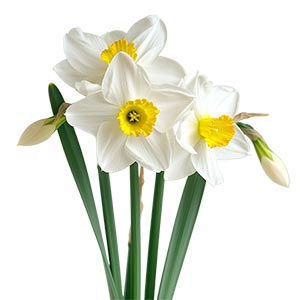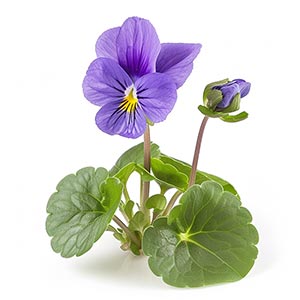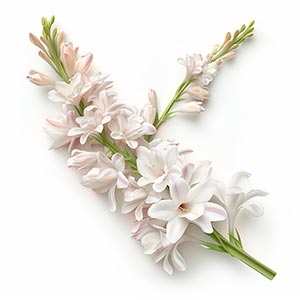The Floral fragrance family is perhaps the most extensive and popular category within perfumery, embodying the essence of flower gardens, bouquets, and the natural aroma of blooming flowers. Floral scents are the heart of many perfumes, offering a wide range of fragrances from the delicate and subtle to the bold and intoxicating. This family captures the pure beauty of flowers, from the sweetness of roses and the lushness of lilies to the exotic allure of jasmine and the softness of lavender.
Floral fragrances are synonymous with femininity and romance, evoking the timeless beauty and the delicate complexity of flowers. They can range from single flower scents, known as soliflores, which highlight the aroma of a single flower, to complex floral bouquets that blend multiple floral notes to create a harmonious and multifaceted scent profile. Floral fragrances are versatile and can convey a spectrum of moods and emotions, from innocence and freshness to depth and sensuality.
The progression of floral fragrances was markedly advanced by the Industrial Revolution, which introduced refined extraction techniques like enfleurage and distillation. These advancements enabled perfumers to more effectively capture the essence of flowers, leading to the creation of more nuanced and intricate floral compositions. The late 19th and early 20th centuries marked a golden age for perfumery, with the creation of iconic floral fragrances that continue to be celebrated. The advent of synthetic ingredients further broadened the perfumer's toolkit, allowing for the reproduction of floral scents that had been challenging to extract, and ushering in an era of innovation and creativity within the floral fragrance family.
Today, the floral fragrance family remains a dominant force in the perfume industry, driven by ongoing innovations in chemistry and the globalization of the marketplace. Modern floral scents encompass a wide range, from traditional soliflores focusing on a single flower to intricate blends that recreate the scent of an entire garden. Looking forward, the industry's focus on sustainability and ethical sourcing of ingredients signals a move towards floral fragrances that not only delight the senses but are also conscientious of their environmental impact. Advances in biotechnology and green chemistry hold the promise of a new generation of floral scents that marry olfactory pleasure with ecological responsibility, ensuring the enduring appeal and relevance of floral fragrances.
Floral fragrances are synonymous with femininity and romance, evoking the timeless beauty and the delicate complexity of flowers. They can range from single flower scents, known as soliflores, which highlight the aroma of a single flower, to complex floral bouquets that blend multiple floral notes to create a harmonious and multifaceted scent profile. Floral fragrances are versatile and can convey a spectrum of moods and emotions, from innocence and freshness to depth and sensuality.
History
Floral fragrances, with their rich history and deep cultural significance, have been a cornerstone of perfumery since ancient times. In ancient civilizations, flowers played a pivotal role in religious ceremonies and personal adornment, marking the beginnings of their use in creating scents. The Egyptians, in particular, are noted for their advanced scent techniques, incorporating floral extracts such as jasmine and lily into burial rituals and daily life, showcasing the intrinsic value and symbolism flowers held within their society. This tradition of floral scents continued to evolve, particularly flourishing during the Renaissance in Europe, where the burgeoning art of perfumery saw floral essences derived from roses, violets, and other blooms become symbols of purity, beauty, and the ephemeral nature of existence.The progression of floral fragrances was markedly advanced by the Industrial Revolution, which introduced refined extraction techniques like enfleurage and distillation. These advancements enabled perfumers to more effectively capture the essence of flowers, leading to the creation of more nuanced and intricate floral compositions. The late 19th and early 20th centuries marked a golden age for perfumery, with the creation of iconic floral fragrances that continue to be celebrated. The advent of synthetic ingredients further broadened the perfumer's toolkit, allowing for the reproduction of floral scents that had been challenging to extract, and ushering in an era of innovation and creativity within the floral fragrance family.
Today, the floral fragrance family remains a dominant force in the perfume industry, driven by ongoing innovations in chemistry and the globalization of the marketplace. Modern floral scents encompass a wide range, from traditional soliflores focusing on a single flower to intricate blends that recreate the scent of an entire garden. Looking forward, the industry's focus on sustainability and ethical sourcing of ingredients signals a move towards floral fragrances that not only delight the senses but are also conscientious of their environmental impact. Advances in biotechnology and green chemistry hold the promise of a new generation of floral scents that marry olfactory pleasure with ecological responsibility, ensuring the enduring appeal and relevance of floral fragrances.

Evocative Nature & when to wear
Floral fragrances have the unique ability to transport the wearer to a world of beauty and serenity, reminiscent of a blooming garden in spring. They evoke feelings of love, joy, and femininity, making them a popular choice for weddings, romantic evenings, and any occasion that calls for elegance and sophistication. Floral scents are also often used to uplift the mood and create a sense of comfort and well-being.Daytime and Casual Occasions: Floral fragrances, with their bright and uplifting notes, are perfect for daytime wear. They shine in casual settings, offering a fresh and approachable aura that's as fitting for a weekend brunch as it is for a day at the office.
Spring and Summer: The natural, blooming essence of floral perfumes makes them especially suitable for the warmer months of spring and summer. Their light, airy qualities resonate with the rejuvenation and vibrancy of these seasons, complementing the lighter attire and outdoor activities.
Romantic Occasions: The inherent sweetness and femininity of floral scents lend themselves beautifully to romantic dates or evenings. Whether it's a bouquet of roses or the delicate whisper of jasmine, floral fragrances can encapsulate the essence of romance.
Weddings and Special Events: For weddings and grand celebrations, floral fragrances offer a classic and elegant choice. They can mirror the floral arrangements and add a layer of sophistication and grace to the wearer's presence.
Relaxation and Comfort: Certain floral scents, especially those with lavender or chamomile, can also be suited for moments of relaxation and comfort, providing a soothing backdrop to unwind and destress.

Characteristics of Floral Fragrances
Floral fragrances stand as the epitome of femininity and romance, embracing the broad spectrum of the floral kingdom. Renowned for their versatility and depth, these scents range from the delicate simplicity of a single flower to complex bouquets combining numerous floral notes. The classic Floral structure is often categorized as follows:Top Notes: Light and fresh accents such as lily of the valley, peony, or rose, introducing the fragrance with a soft, inviting aroma that gently transitions into the heart of the scent.
Heart Notes: The essence of the fragrance, featuring fuller, more voluptuous floral notes such as jasmine, tuberose, or gardenia. This middle layer represents the core of the floral theme, offering richness and depth.
Base Notes: Subtle hints of musk, vanilla, or sandalwood that provide a warm, enduring foundation. These notes support and enhance the floral heart, adding complexity and ensuring the fragrance's longevity on the skin.
Main Components and Notes of Floral Fragrances
Roses: Symbolic of love and beauty, rose scents are a cornerstone of Floral fragrances.Jasmine: Known for its rich and highly fragrant aroma, adding depth and sensuality.
Lavender: Offers a fresh, clean, and slightly herbal note.
Gardenia and Tuberose: Provide rich, creamy, and intoxicating tropical floral scents.
Lilies and Orchids: Contribute exotic and diverse aromas, from spicy to soft and powdery.

Jasmine one of the most popular notes in perfumery, is at the heart of many floral fragrances.

Peony gives a fresh, soft floral note: uplifting, calming, working brilliantly alongside other floral notes.

Freesia, with its sweet, fruity and floral scent, adds a touch of elegance and sophistication to fragrances.

A unique fragrance that is both floral and lemon-scented, with a hint of honey-like sweetness.

Iris adds a sophisticated, powdery and floral nuance to fragrances, and is known for its elegant and complex scent.

Narcissus is a sweet and spicy ingredient that adds a fresh and bright quality to fragrances.

Gardenia, with its sweet, fruity and floral scent, adds a touch of elegance and sophistication to fragrances.

Orchid is a delicate and exotic fragrance ingredient known for its floral and sweet notes. It is commonly used in Floral and Oriental fragrance families.

Chamomile in fragrances is known for its soothing, mildly sweet, and herbal aroma, contributing a gentle and calming quality to scents.

Geranium offers a floral and slightly minty aroma, commonly used in floral, fresh, and herbal fragrances for its vibrant character.
Popular Floral Fragrances
Women's Fragrances
Daisy by Marc JacobsA youthful and spirited fragrance, capturing a playful brightness with a blend of strawberry, violet leaves, and jasmine.
La Vie Est Belle by Lancôme
A unique olfactory signature scent created by three of France's leading perfumers, encapsulating iris with a hint of patchouli and sweet gourmand.
Coco Mademoiselle by Chanel
An elegant, luxurious scent in a classic bottle, featuring strong notes of orange, rose, and vanilla.
Mon Guerlain by Guerlain
A fresh and luminous fragrance celebrating lavender, jasmine, sandalwood, and vanilla.
Black Opium by Yves Saint Laurent
An addictive gourmand floral with notes of black coffee, white flowers, and vanilla for a seductive warmth.
Men's Fragrances
Light Blue Pour Homme by Dolce & GabbanaA citrus aromatic fragrance with a blend of mandarin, bergamot, grapefruit, and juniper.
Le Male by Jean Paul Gaultier
A balance of toughness and sensuality, with lavender, mint, and orange blossom notes.
Eros by Versace
A fragrance that interprets sublime masculinity through a luminous aura with an intense, vibrant, and glowing freshness.
Black Orchid Parfum by Tom Ford
A luxurious and sensual fragrance of rich, dark accords and an alluring potion of black orchids.
Guilty Pour Homme by Gucci
An intense and individual contemporary fougere that provokes as it seduces with lemon, lavender, and patchouli.





